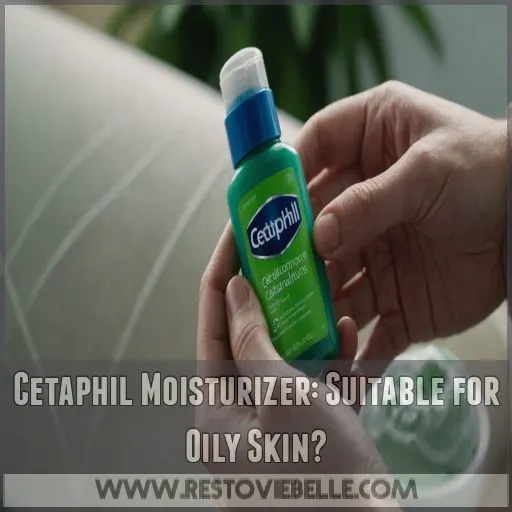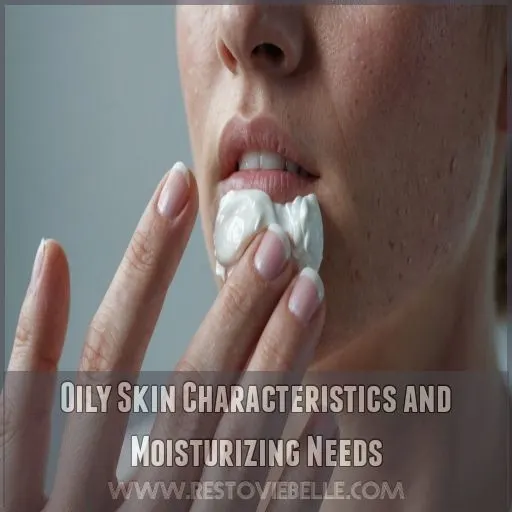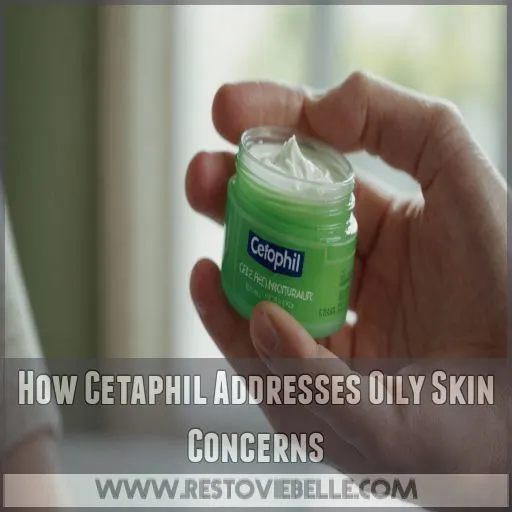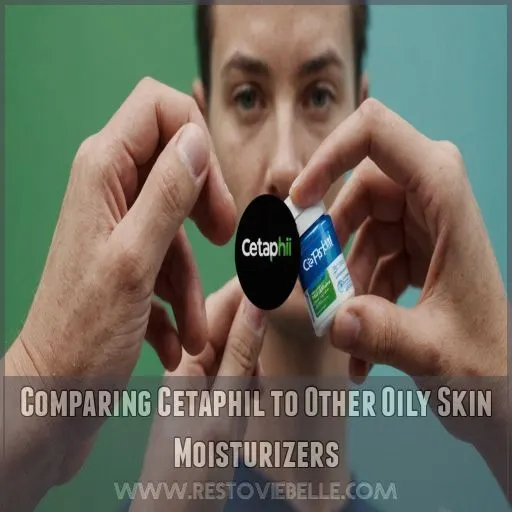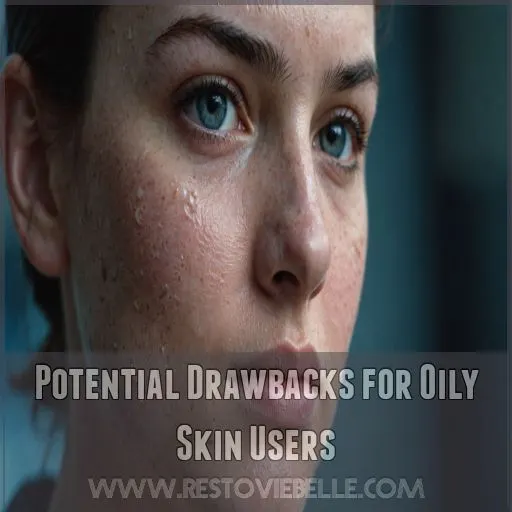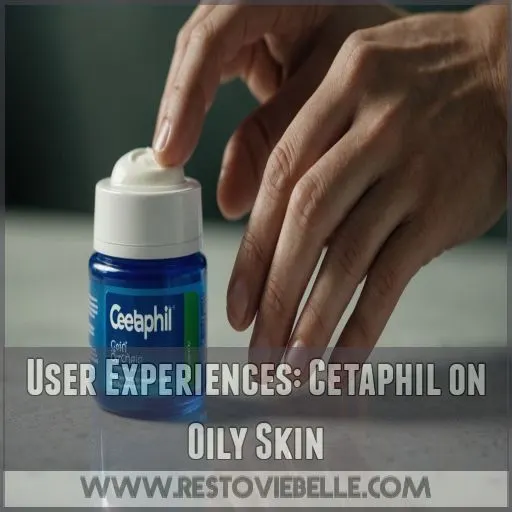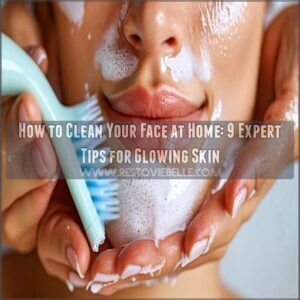This site is supported by our readers. We may earn a commission, at no cost to you, if you purchase through links.
 Wondering how good Cetaphil moisturizer is for oily skin? You’re not alone! The verdict: it’s pretty darn good.
Wondering how good Cetaphil moisturizer is for oily skin? You’re not alone! The verdict: it’s pretty darn good.
Cetaphil’s oil-free, non-comedogenic formula is like a gentle hug for your overactive sebaceous glands. It hydrates without turning your face into an oil slick, and its lightweight texture absorbs faster than you can say "matte finish."
While it’s not a miracle worker, many oily-skinned folks swear by its ability to balance sebum production and keep shine at bay.
But here’s the kicker: everyone’s skin is unique. Some users report breakouts or residue, so patch testing is your best friend.
Stick around to uncover the shocking truth about Cetaphil’s secret weapon for oily skin!
Table Of Contents
- Key Takeaways
- Cetaphil Moisturizer: Suitable for Oily Skin?
- Oily Skin Characteristics and Moisturizing Needs
- How Cetaphil Addresses Oily Skin Concerns
- Comparing Cetaphil to Other Oily Skin Moisturizers
- Potential Drawbacks for Oily Skin Users
- User Experiences: Cetaphil on Oily Skin
- Dermatologist Opinions on Cetaphil for Oily Skin
- Incorporating Cetaphil Into Oily Skin Routines
- Tips for Maximizing Cetaphil’s Benefits on Oily Skin
- Frequently Asked Questions (FAQs)
- Is Cetaphil or CeraVe better for oily skin?
- What is the best moisturizer for oily skin?
- Is Cetaphil moisturizer pore clogging?
- What are the benefits of Cetaphil for oily skin?
- Does Cetaphil moisturizer cause breakouts on oily skin?
- How long does Cetaphil take to absorb?
- Can Cetaphil be used under makeup?
- Is Cetaphil moisturizer non-comedogenic?
- How does Cetaphil perform in hot, humid climates?
- Conclusion
Key Takeaways
- You’re in luck – Cetaphil’s oil-free, non-comedogenic formula is like a gentle hug for your overactive sebaceous glands. It hydrates without turning your face into an oil slick, striking that elusive balance between moisture and a matte finish.
- Don’t expect miracles, but many people with oily skin swear by Cetaphil’s ability to tame the shine for oily skin types. Its lightweight texture absorbs quickly, giving you a smooth canvas for makeup or a fresh-faced look.
- Your mileage may vary – while Cetaphil works wonders for some, others find it too heavy or pore-clogging. It’s like dating – you might need to try a few different products before finding your ideal moisturizer.
- Dermatologists often give Cetaphil a thumbs up for oily skin, but they’ll remind you that it’s not one-size-fits-all. Be sure to patch test before committing, and remember – your skin is as unique as your Netflix recommendations, so what works for your best friend might not work for you.
Cetaphil Moisturizer: Suitable for Oily Skin?
If you’re wrestling with oily skin, you might be eyeing Cetaphil moisturizer as a potential solution.
Let’s uncover the truth about how well this popular product works for those of us battling excess shine and explore whether it’s really up to the task of keeping our oily complexions in check.
Ingredients Analysis for Oily Skin
For oily skin, not all moisturizers are created equal.
Let’s break down the ingredients of Cetaphil moisturizer to see if it’s your skin’s new BFF. You’ll want to look for:
- Oil-controlling superstars
- Hydration heroes that won’t clog pores
- Soothing agents to calm your skin’s temper tantrums
Cetaphil’s formula boasts a mix of ingredients that might just hit the sweet spot for oily skin types, especially when considering toners for oily skin. But before you jump on the bandwagon, let’s break it down.
Oil-Free Formulation
You’ve heard about ingredients, but let’s talk about what’s not in Cetaphil moisturizer: oil! This oil-free formulation is a game-changer for oily skin, especially when you consider the key ingredients to look for in oily skin exfoliators.
Here’s why it matters:
| Oil-Free Benefits | Impact on Oily Skin |
|---|---|
| No added oils | Reduces shine |
| Lightweight feel | Doesn’t clog pores |
| Quick absorption | Prevents greasiness |
| Balances skin | Controls oil production |
| Hydrates without heaviness | Keeps skin comfortable |
It’s like giving your skin a drink of water without the greasy aftermath. Your face will thank you!
Non-Comedogenic Properties
Moving beyond oil-free formulations, let’s explore Cetaphil’s non-comedogenic properties.
You’ve probably heard this term tossed around, but what does it mean for your oily skin? Simply put, non-comedogenic ingredients won’t clog your pores.
It’s like giving your skin a chance to breathe!
Cetaphil’s moisturizer is designed to play nice with oily skin, reducing the risk of breakouts and keeping your complexion clear.
It’s a game-changer for those prone to pesky pimples.
Hydration Without Excess Shine
You’re after that elusive balance: hydration without the dreaded oil slick. Cetaphil’s moisturizer might just be your secret weapon. Here’s why it could work for your oily skin:
Cetaphil’s moisturizer offers several benefits for oily skin: like oil control properties
- Lightweight formula absorbs quickly
- Provides oil-free hydration
- Helps balance sebum production
Think of it as a nice drink for your skin, not a heavy meal. It’s like giving your face a cool glass of water on a hot day – soothing without the extra shine.
Oily Skin Characteristics and Moisturizing Needs
If you’ve got oily skin, you’re not alone. It’s like your face decided to be its own oil refinery! But don’t fret – understanding your skin’s quirks is half the battle won. Oily skin tends to have larger pores and a shiny appearance, often due to overactive sebaceous glands.
While it might seem counterintuitive, your oily skin still needs hydration. The trick is finding the right balance. Moisturizing helps maintain your skin’s protective barrier, preventing dehydration that can actually trigger more oil production. Look for lightweight, non-comedogenic products that won’t clog your pores. Water-based or gel moisturizers are often your best bet.
And here’s a pro tip: don’t skip the face wash! A gentle, paraben-free cleanser can help control excess oil without stripping your skin. Remember, treating oily skin is a bit like taming a wild stallion – it takes patience and the right approach.
How Cetaphil Addresses Oily Skin Concerns
You might be wondering if Cetaphil moisturizer can tackle your oily skin woes, especially since it’s marketed as gentle and suitable for sensitive skin. for oily skin.
Let’s uncover how this popular product aims to balance oil production, provide lightweight hydration, and keep shine at bay without clogging your pores.
Balancing Oil Production
After understanding your skin’s unique needs, let’s tackle the oil slick!
Cetaphil’s moisturizer is like a skilled tightrope walker, balancing your skin’s oil production. It’s designed to hydrate without flooding your face, potentially reducing that dreaded midday shine.
The secret? A blend of ingredients that work with your skin, not against it.
Lightweight Texture
While some moisturizers feel like a heavy blanket on your skin, Cetaphil’s lightweight texture is more like a gentle caress. It’s designed to address oily skin concerns without weighing you down.
Cetaphil’s lightweight texture is designed to address oily skin concerns without weighing you down.
Here’s what makes Cetaphil’s texture stand out:
- Gel-like consistency that feels barely there
- Matte finish that doesn’t add shine
- Oil-free formula that won’t clog pores
- Breathable barrier that lets skin "breathe"
- Customized feel for oily skin types
Quick Absorption
Speedy absorption is the name of the game for Cetaphil’s oily skin solution, which is a key consideration when choosing a moisturizer for oily skin. You’ll notice the difference as soon as you apply it. Let’s break down how this moisturizer tackles quick absorption:
| Factor | Impact on Oily Skin |
|---|---|
| Texture | Lightweight feel |
| Consistency | Non-greasy formula |
| Hydration | Balanced moisture |
| Skin Feel | Smooth, not sticky |
Say goodbye to that dreaded slick feeling! Cetaphil’s fast-absorbing formula means you can moisturize without worrying about a greasy aftermath.
Mattifying Effects
Many Cetaphil users wonder about its mattifying effects on oily skin.
While it’s not specifically marketed as a mattifying product, some find it helps control shine.
Here’s what you should know:
- Contains lightweight, non-greasy ingredients
- May absorb excess oil without over-drying
- Can create a smooth base for makeup application
- Doesn’t promise long-lasting oil control like clay masks
- Might need reapplication throughout the day for shine control
You’re probably thinking, "Great, but will it turn my face into an oil slick?" Don’t worry! Cetaphil’s formula aims to strike a balance between hydration and oil control.
Comparing Cetaphil to Other Oily Skin Moisturizers
How does Cetaphil stack up against other moisturizers for oily skin? Let’s take a closer look and compare. When you’re battling shine, you need a heavyweight champion in your corner. Cetaphil’s oil-free formula goes toe-to-toe with popular contenders like CeraVe and Neutrogena.
Price-wise, Cetaphil often comes out as the budget-friendly option, giving your wallet a break.
Ingredient-wise, it’s a mixed bag. While Cetaphil lacks the hyaluronic acid found in some competitors, it makes up for it with a simple, non-irritating formula.
User reviews often praise Cetaphil’s gentleness, but some find it less effective for intense hydration compared to products with a triple acid blend. For nighttime use, you might want to explore specialized night creams.
Potential Drawbacks for Oily Skin Users
Cetaphil’s moisturizer is popular, but it may not be ideal for everyone with oily skin.
You’ll want to think about potential drawbacks like breakouts, greasy residue, and pore-clogging before slathering it on your face.
Breakout Risks
While Cetaphil’s moisturizer is a hit for dry skin, it might not be your oily skin’s best friend.
Let’s face it: breakouts are the last thing you want when trying to hydrate your complexion.
Here’s what you need to know about potential acne triggers:
- Pore-clogging ingredients can lead to stubborn blemishes
- Heavy formulas may overwhelm oily skin types
- Incompatibility with acne treatments can worsen breakouts
- Individual skin reactions vary, making patch testing essential
Don’t let your moisturizer be the villain in your skincare story!
Greasy Residue Concerns
| Concern | Cause | Solution |
|---|---|---|
| Shiny forehead | Over-application | Use a pea-sized amount |
| Slick T-zone | Rapid oil production | Blot with oil-absorbing sheets |
| Makeup sliding off | Residue build-up | Apply a mattifying primer |
| Sticky feeling | Poor absorption | Gently massage in circular motions |
Pore-Clogging Potential
Every single pore on your face could be at risk when using Cetaphil moisturizer on oily skin. While it’s labeled as non-comedogenic, some users still report clogged pores.
Here’s what you need to watch out for:
- Increased blackhead formation
- Enlarged pore appearance
- Stubborn whiteheads
- Excess sebum trapped in pores
- Dull, congested-looking skin
Don’t let your moisturizer become a pore-clogging nightmare! It’s important to listen to your skin and adjust your routine accordingly.
Skin Irritation Possibilities
Cetaphil’s reputation for sensitive skin doesn’t guarantee a smooth ride for everyone. You might find yourself in a sticky situation if your oily skin reacts poorly. Let’s break down the potential irritation issues:
| Concern | Symptoms | Possible Cause | Solution |
|---|---|---|---|
| Redness | Flushed skin | Ingredients sensitivity | Patch test |
| Stinging | Discomfort | pH imbalance | Adjust usage |
| Itching | Scratchy feeling | Allergic reaction | Consult dermatologist |
| Breakouts | New pimples | Pore-clogging | Try oil-free alternative |
Don’t let these possibilities scare you off – many oily-skinned folks swear by Cetaphil. Just listen to your skin’s whispers (or screams).
User Experiences: Cetaphil on Oily Skin
In the trenches of skincare battles, users with oily skin have shared mixed experiences with Cetaphil moisturizer.
You’ll find some singing its praises, claiming it’s their holy grail for balanced hydration. They rave about how it doesn’t leave their face feeling like an oil slick by midday.
On the flip side, others have found themselves in a sticky situation. "It’s like my face turned into a slip-and-slide!" one user quipped. Some report unexpected breakouts, especially in areas they don’t usually see pimples.
The verdict? It’s a bit of a rollercoaster ride. For every person who swears by its lightweight feel, there’s another who finds it too heavy for daytime use. Your mileage may vary, but many agree it’s worth a shot if you’re on the hunt for a moisturizer that plays nice with oily skin.
Dermatologist Opinions on Cetaphil for Oily Skin
You’ve heard from users, but what do the experts say? Dermatologists often weigh in on Cetaphil for oily skin, and their opinions might surprise you. Many skin docs actually give Cetaphil a thumbs up, praising its non-comedogenic formula and gentle approach to hydration. They point out that oily skin still needs moisture, and Cetaphil’s lightweight texture can fit the bill without clogging pores.
However, it’s not all smooth sailing. Some dermatologists caution that while Cetaphil can work wonders for many, it’s not a one-size-fits-all solution. They recommend patch testing first, especially if you’re acne-prone. A few even suggest alternatives with more active ingredients for hardcore oil control.
Incorporating Cetaphil Into Oily Skin Routines
If you’ve decided to give Cetaphil a try for your oily skin, you’ll want to know how to use it effectively.
Applying Cetaphil effectively requires understanding when and how to incorporate it into your skincare routine.
Let’s explore some practical tips for achieving the best results.
Application Techniques
After considering expert opinions, let’s talk about how to apply Cetaphil moisturizer for oily skin.
The trick is in the technique!
Start with clean hands and a pea-sized amount.
Warm it between your fingertips, then gently pat it onto your face.
Don’t rub that can stimulate oil production.
Focus on drier areas first, using upward motions.
Frequency of Use
Cetaphil moisturizer is generally recommended for use twice daily, in the morning and evening.
However, your skin’s needs may vary.
During drier seasons or after harsh treatments, you may need to apply moisturizer more frequently.
Listen to your skin; it is the best guide for determining how often to moisturize.
Consistency is key in any skincare regimen.
Day Vs. Night Usage
If you’re using Cetaphil moisturizer, timing is everything for oily skin.
Your skin’s needs change throughout the day, so let’s break down the day vs. night usage:
- Morning: Light application for oil control under makeup
- Evening: Heavier application for overnight hydration
Post-cleansing: Apply to damp skin for better absorption.
Seasonal adjustments: Lighter in summer, richer in winter.
Tips for Maximizing Cetaphil’s Benefits on Oily Skin
If you’ve got oily skin and you’re using Cetaphil moisturizer, you might be wondering how to make the most of it.
Let’s explore some clever tips and tricks to help you optimize Cetaphil’s benefits for your oily complexion, ensuring you get the hydration you need without turning into a grease factory.
Application Techniques
Mastering the art of applying Cetaphil moisturizer can make all the difference for your oily skin. Let’s explore some game-changing techniques that’ll help you get the most out of this product:
Using a pea-sized amount prevents overuse and shine.
Patting, don’t rubbing enhances absorption.
Applying to damp skin locks in hydration.
Layering with other products customizes your routine.
| Technique | Benefit |
|---|---|
| Use a pea-sized amount | Prevents overuse and shine |
| Pat, don’t rub | Enhances absorption |
| Apply to damp skin | Locks in hydration |
| Layer with other products | Customizes your routine |
Product Selection Guidelines
You’re on a mission to find the perfect Cetaphil moisturizer for your oily skin.
Here’s your battle plan: First, zero in on products labeled "oil-free" or "for oily skin."
Next, scrutinize those ingredient lists like a detective – look for non-comedogenic superstars like hyaluronic acid and niacinamide.
Don’t forget to check user reviews from fellow oil-fighters.
And remember, your skin’s unique, so what works for others mightn’t be your holy grail.
Skin Preparation Methods
Now that you’ve picked the right Cetaphil product, let’s talk skin prep!
Start with a gentle cleansing routine to remove excess oil.
Follow up with a light exfoliation to clear those pores.
A toner can help balance your skin’s pH, while a hydrating serum adds an extra moisture boost.
These pre-moisturizer steps are like rolling out the red carpet for Cetaphil, ensuring it works its magic on your oily skin!
Frequently Asked Questions (FAQs)
Is Cetaphil or CeraVe better for oily skin?
It’s lighter, absorbs quickly, and contains ceramides that help balance oil production.
While Cetaphil can be heavy and potentially pore-clogging, CeraVe’s formula is designed to hydrate without the greasy aftermath.
What is the best moisturizer for oily skin?
Looking for the perfect moisturizer for oily skin?
Try lightweight, oil-free formulas with ingredients like hyaluronic acid, niacinamide, or salicylic acid.
Gel-based options absorb quickly and won’t clog pores.
Remember, a little goes a long way when you apply it!
Is Cetaphil moisturizer pore clogging?
Oh, you’re in for a pore-fect surprise! Cetaphil moisturizer isn’t a pore-clogger’s dream come true.
It’s non-comedogenic, meaning it won’t block your pores.
However, if you’ve got oily skin, you might want to tread carefully.
What are the benefits of Cetaphil for oily skin?
You’ll find Cetaphil’s benefits for oily skin are limited.
It’s not your best bet, as it’s quite heavy and can clog pores.
You’re better off seeking a lighter, oil-free moisturizer specifically designed for oily complexions.
Does Cetaphil moisturizer cause breakouts on oily skin?
Cetaphil moisturizer is not recommended for oily skin.
It is known to cause breakouts, especially for acne-prone individuals.
Several users report pimples in unusual areas and increased skin irritation.
Consider alternatives better suited for your skin type.
How long does Cetaphil take to absorb?
Cetaphil can take a while to sink in.
You might feel like you’re wearing a moisturizer mask for 10-15 minutes!
It’s a bit of a slow dancer, so give it time to work its magic.
Can Cetaphil be used under makeup?
While Cetaphil can be used under makeup, it might not be ideal for everyone.
The thick, heavy texture can take time to absorb and may leave your skin looking shiny.
For best results, apply sparingly and allow ample drying time.
Is Cetaphil moisturizer non-comedogenic?
Imagine your face as a delicate garden.
Cetaphil moisturizer is non-comedogenic, meaning it won’t clog your pores.
It’s designed to nourish your skin without causing breakouts.
However, everyone’s skin is unique, so patch-test first.
How does Cetaphil perform in hot, humid climates?
You’ll find Cetaphil’s performance in hot, humid climates a bit hit-or-miss.
It’s like wearing a thick sweater on a summer day – might be too heavy.
Consider a lighter option if you’re sweating buckets in tropical heat.
Conclusion
Did you know that 85% of people with oily skin struggle to find the right moisturizer?
Cetaphil’s moisturizer for oily skin might just be your holy grail.
While it’s not perfect for everyone, its oil-free, non-comedogenic formula ticks many boxes.
Ultimately, how good Cetaphil moisturizer is for oily skin depends on your individual needs.
Give it a shot you might just join the ranks of satisfied, shine-free users!

